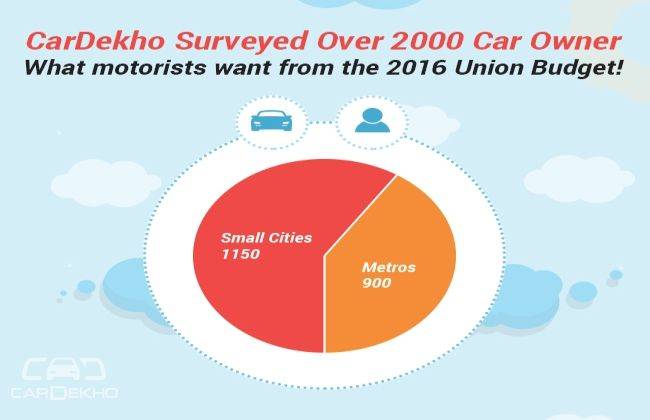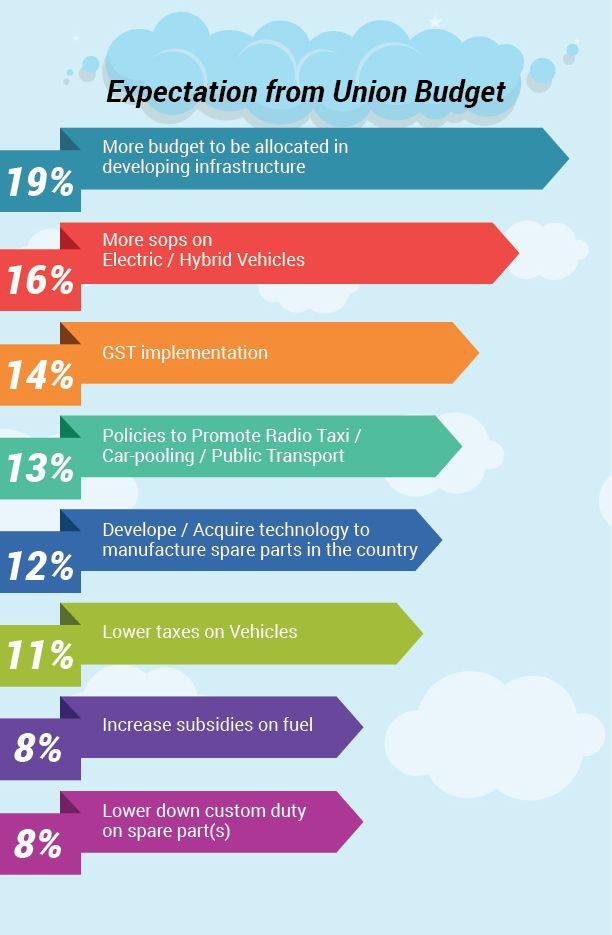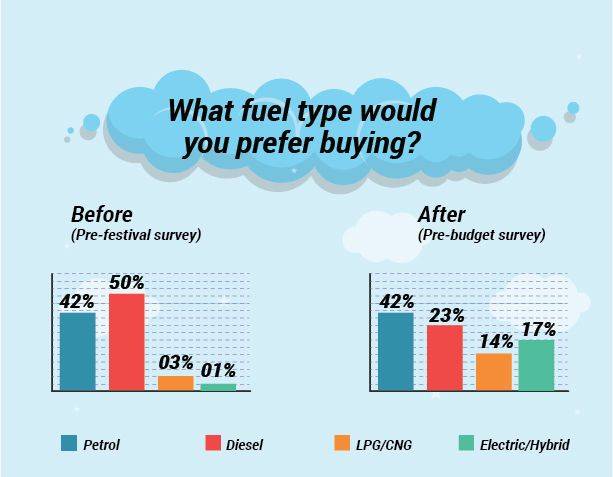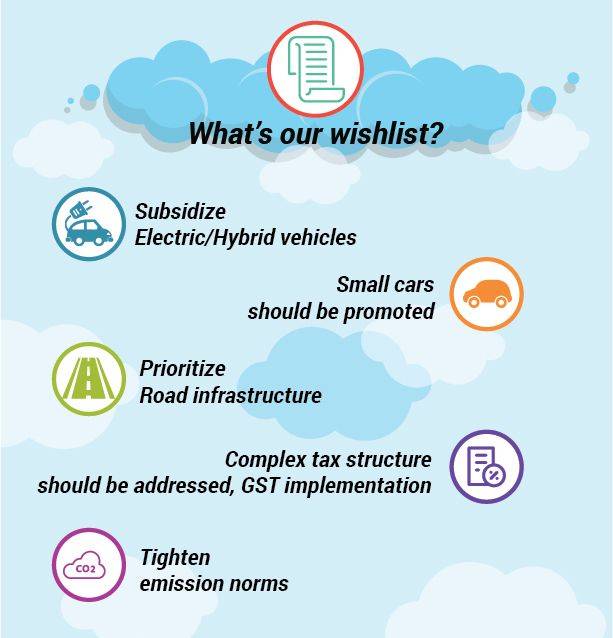The 2016 Union Budget is right around the corner. While only Mr. Arun Jaitley knows for sure as to what his budget briefcase holds, we surveyed avid motorists around the country to tell us what their expectations from the Union Budget 2016 are. During the survey, we spoke to over 2000 people to know what they want from the upcoming Union Budget 2016. The survey included a good mix of people from metros and non-metros to get a pulse of expectations, pan India. The response has been heartening and here are the key takeaways from the survey:

Part I : The Basics

The key expectation continued to remain ‘a need for better infrastructure’. Moreover, it was good to know that this need was coupled with active voices for decongesting the roads (by introduction of a policy to promote use of car-pooling and public transport). We also got several opinions stating that cycling should be promoted and incentivized for shorter commutes. Government should introduce a policy whereby people are incentivised on use of car-pooling and public transport. The second major expectation was towards more sops on Electric/ Hybrid vehicles. In the government’s move towards green environment, it is imperative to encourage the use of hybrid and electric vehicles so as to have a pollution free environment and to save our scarce resources (fossil fuels). Implementation of GST remains another major expectation of the people surveyed. Though GST is not a magical wand that will cure all the issues with regard to taxation of goods and services, yet a well-framed GST could alleviate the taxation aspects and mitigate the complexities under the existing taxation laws. Surveyors also shown their expectations on development/ acquisition of technology to manufacture spare parts in the country, lowering taxes on vehicles, lowering custom duty on import of spare part(s) and increasing subsidies on fuel.
The metros and non-metros were pretty much neck and neck on all demands. Not a big rift was seen in the demands changing due to geographic differences. That said, metro residents do expect better roads and public transport.

Amongst other expectations, the major expectation of the mass was more towards ‘more budget to be allocated in developing infrastructure’ (both in Metro and Non-Metro). The biggest drag on India’s competitiveness has been the infrastructure sector and there remains a huge gap between our growth aspirations and the current support available. Financing need of infrastructure projects is huge and remains a major challenge. India needs a strong investment in infrastructure to improve safety, reduce congestion, enhance mobility and produce economic benefits. The manufacturing industry in India has a great potential. In keeping with the theme of development, Prime Minister Mr. Narendra Modi has also introduced the “Make in India” campaign, with an aim to transform India into a manufacturing leader. Though many efforts have been undertaken, many more (both at individual and group level) are still needed to have a Global competitiveness. While glancing through other expectations, it is clear that people want to have a better standard of living through better infrastructure facilities and pollution free environment and to have a better taxation regime through introduction of GST, reduction of custom duty and lower taxes on vehicles, so as to match the Global landscape, which is evolving at a fast pace.
Better roads, please?

Infrastructure development is a pre-requisite for the growth and development of any country. Infrastructure development can be achieved in two ways i.e. either to build altogether new infrastructure or to upgrade/ enhance the existing structure. Both activities entail huge investment and human efforts. The Road Ministry was allocated a total of ‚¹ 40,000 crores in the last budget. The Government has remained committed to accelerate infrastructure activities in the country. Accordingly, this year, the ministry seeks twice of that. The ministry aims to ramp up road-building from the present 18 km/day to 30 km/day. This also includes the Ministry’s ambitious Bharat Mala project that envisages an additional 25,000 kms of roadways connecting the country by the year 2022. Moreover, the ministry has also proposed to construct more expressways, out of which few have already been approved by the Cabinet. On the survey question, nearly half of the people believed that the spend on infrastructure is moving in the right direction. That said, metro city residents, especially in Bangalore were particularly vocal on having more spend for developing not just infra, but also public transport. The current growth in the economy, which is seeing a corresponding increase in demand for services, means that a more appropriate level of funding for infrastructure is now needed. If we fail to provide for adequate resources, we run the risk of hampering our future economic growth and increased congestion which has the capacity to stifle the steady progress we have been making.
Subsidize Electric Vehicles & Hybrids!

Nearly 70% of the respondents said that they would buy an Electric Vehicle if they were properly subsidized by the government. It goes without saying that the subsidies need to be accompanied by relevant infrastructure in terms of charging stations. In the government’s move towards green environment, it is imperative to encourage the use of hybrid and electric vehicles. Deficiency in infrastructure for manufacturing of electric vehicle is a major factor that affects consumer’s sentiment in this sector. The government should boost this sector by granting incentives/ subsidies so that people are encouraged to use Electric Vehicles. Currently, Electric Vehicles & Hybrids, are without a doubt - the last choice on a new car buyer’s list. Fact is, Electric Vehicles are very expensive to manufacture. Sure, we will see prices plummet once battery technology is more efficient and cheaper. Upto that point however, the Government has some hand-holding to do. With only Mahindra jumping with a blindfold and a prayer, the Electric Vehicle space is as good as non-existent at the moment. Yes, the government did setup FAME (Faster Adoption and Manufacturing of Electric Vehicles) – introduced in Budget 2015 - and provided an 80 Crore grant to the ARAI for R&D. In our books, that is mere tokenism. Policies and subsequent budgeting for eco-friendly/electric vehicles definitely need a jolt.
With states being asked to take up electric vehicle sector as a priority, would go a long way in making the initiative a nationwide success. Moreover, additional tax benefits should be introduced for undertaking R&D activities and manufacturing of Electric Vehicles. The infrastructure sector is looking forward to the government for the required fiscal and policy support for the macro economic growth. It is the time that bold reforms are undertaken to develop/ augment our infrastructure sector, else the ambitious growth targets/ global competitiveness would be merely vivid dreams.
Part II : The Environmental Concerns
The masses also expressed opinions on doing their bit for the environment. In the wake of the recent pollution saga in Delhi (and the knee-jerk ban that followed); environmental concerns were not sidelined whilst voicing expectations from the budget. To make India pollution free, there is a need to encourage use of electric & hybrid vehicles, which should be run on environment-friendly fuels such as bio-diesel and ethanol or electricity. National Electric Mobility Mission Plan (NEMMP), announced in 2013, is one of the initiatives which in addition to supporting the industry, also seeks to create a significant positive impact on the health index of the country by promoting zero pollution electric vehicles and reducing the dependence on the fossil fuels. The government should introduce such other plans/ initiatives to completely curb/ control the pollution and its dangerous effects which as on date are acting as termites, slowly damaging our environment, our society and our families.
Detesting Diesel

We witnessed a sharp decline in preference for diesel vehicles. Unsurprisingly, majority said they would prefer buying a petrol car in the near future over any other fuel type. Alternate fuel (LPG/CNG) cars and EVs have gained substantial traction over diesel counterparts as well. The major factor contributing to this sentiment, is of course - the Delhi diesel ban. The blanket ban of vehicles with diesel engines above 2.0 litres is sure to affect buying behaviour. A substantial portion of respondents said taxing bigger vehicles is the way forward.

In conclusion
While most responses focused on the need for subsidizing EVs and better infrastructure in terms of roadways; we also saw a rising demand for better public transportation. This not only reduces the environmental impact, but also helps de-congesting the roads. We also got unique responses like ‘One Family, One Car’ and a few demands for an inclusive vehicle-scrapping policy. Other thoughts on curbing pollution and shifting to cleaner (and greener) transportation included policies promoting cycling for short distances, banning commercial vehicle entry into cities during peak hours and making emission norms stricter. This is truly a time of great expectations for India. This is truly the time of great reforms to be made for development of India. As the global economy is picking up, Indian government's strong pro-industry stand combined with our core advantages can make a huge impact in developing India as a strong and better nation around the globe. With Make in India initiative, the day is not far when the whole world would be using goods with a tag ‘Make in India’. Though a good start has been made with the government announcing its intent and making a few small yet important changes, there is a long journey ahead of us to achieve global competitiveness followed by claiming global leadership.


